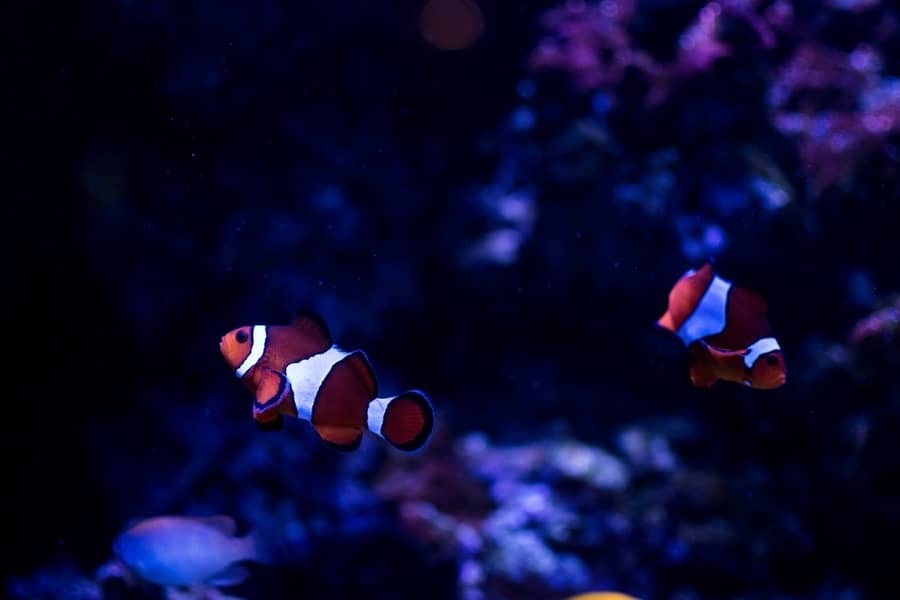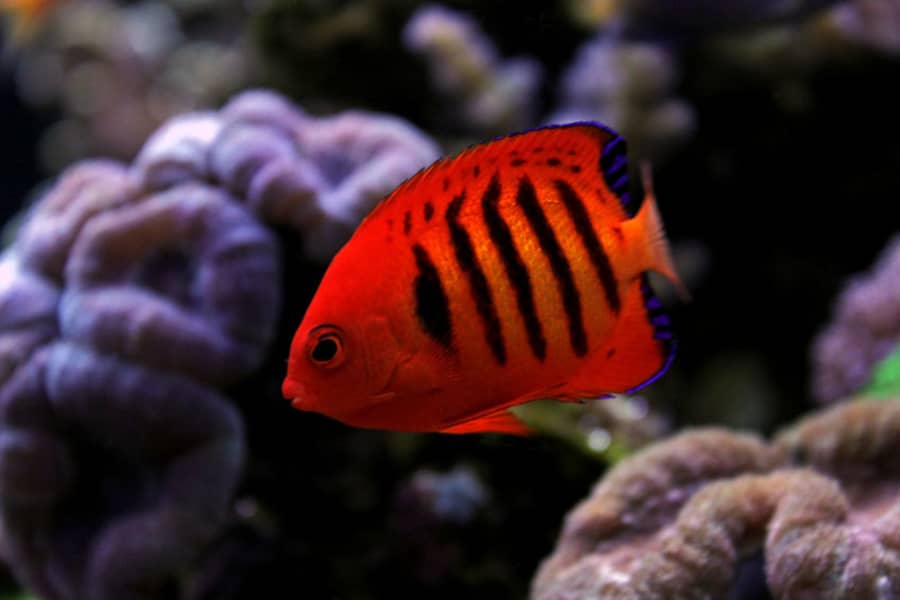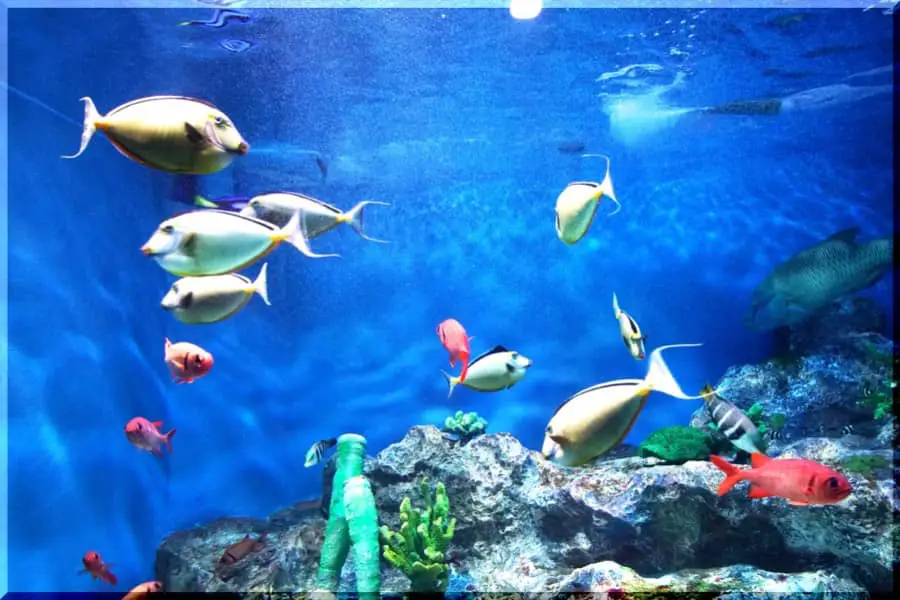Do Fish Need Complete Darkness To Sleep?

If you are taking care of a fish, you want to make sure you are doing so properly. Contrary to popular opinion, there is more to taking care of a fish than making sure it is fed every day. You also need to do other things to give your fish the best life possible, such as wanting to give your fish the optimal amount of light and darkness to ensure its best health, but do they need complete darkness to sleep?
Fish don’t necessarily need complete darkness to sleep, but it’s best to provide them with the amount of darkness they would have in their natural environment. They may sleep when tired if the lights are on, but it will be better for their sleep and overall health if they can rest in darkness.
If you want to know more about the light and dark needs of fish, read on. You might learn some information that will help you become a better owner of your aquatic pet.
What Happens When Fish Sleep?
Some people might wonder what it looks like when a fish is sleeping. After all, they don’t have eyelids, so you can’t see them closing their eyes the way you can see with humans and other animals. This is one reason why people might wonder if fish even sleep. You may be interested to know that all of the evidence points to fish indeed being capable of sleep.
Additionally, it’s different from the way that mammals sleep. When mammals sleep, a part of their brain called the neocortex (the biggest part of the cerebral cortex) will shut down; this doesn’t happen in fish, as a fish does not have a neocortex. Overall, a fish has a much simpler nervous system than a human being, which is why it can be difficult to compare them.
Most of the time, when fish sleep, they will be motionless. Their breathing will slow down significantly, and in some cases, you’ll even be able to pick them up in your hand.
Some people might be shocked or panicked to see their fish so still, as their first thought might be something wrong with the fish. However, in many cases, when you see your fish so motionless, it is just sleeping.
However, some fish, such as tuna and sharks, have to continue to move, even why they are technically sleeping. This is because they need to keep their gills ventilated. The thought is that these fish are sleeping with only half of their brains. Other fish have different sleep habits.
For example, some species of Wrasses and Parrotfish will create a mucus cocoon to surround themselves while they are sleeping; this is believed to protect them from parasites and/or predators.
Actually, at least some fish sleep in ways that can be compared to how humans sleep. Stanford University researchers monitored the activity in the bodies and brains of zebra danios. In one study, they were able to see both deep sleep and slow-wave sleep, just as has been observed in reptiles, birds, and mammals.
The only difference they observed was that during deep sleep, the fish did not show signs of rapid eye movement or REM like other animals do.
You can generally tell that your fish are sleeping when you see these signs:
- The fish are completely still for stretches of time.
- They will be lying on either an object within the aquarium or the bottom of the tank.
- They will be unreactive to whatever is going on in their surroundings.
- They will exhibit all of these behaviors at approximately the same time every day, most likely, when their aquarium light is not on.
Interestingly, the study of sleep in fish is relevant enough to human sleep that helps scientists understand human sleep better. Many studies use zebrafish, for example, to understand different sleep issues, such as insomnia, sleep deprivation, and circadian rhythms.
When Do Fish Sleep?

Scientists believe that most fish actually operate by regular sleep schedules, just as other animals, such as humans. The majority of fish who live in aquariums generally seem to be diurnal, moving around in the daytime and resting at night.
However, this isn’t true with all fish species, as some fish in the wild are nocturnal; they will move around at night and sleep in a dark location, such as a cave, during the daytime.
This can actually be a problem for an uneducated fish owner who buys fish with incompatible sleep schedules and keeps them in the same tank without making the appropriate lighting adjustments (such as a nightlight at night).
For example, catfish are often nocturnal, while Neon tetras are diurnal. This means that the catfish will be looking for food while the Neons are trying to sleep on the bottom of the tank at night, which can present a danger to the Neons.
Of course, if one fish could be potential prey to another, they shouldn’t be in the same tank anyway, but the sleep schedule incompatibility makes disaster even more likely.
There are many species of fish who do not sleep when they are caring for their young. Additionally, certain species, such as Tilapia, don’t even start sleeping until they reach about five or six months of age.
Also, fish in the wild generally don’t sleep when they migrate, although this isn’t going to be an issue with fish confined to an aquarium. Research indicates that blind cavefish don’t sleep, which might be because they’re always in the dark and can’t really tell the difference between day and night.
Most of the time, if you have multiple fish in an aquarium, you will not see all of your fish sleeping at the same time. This is because any fish will sleep when it needs to take a break from its activity, which can happen anytime throughout the day.
Where Do Fish Sleep?

Different species will sleep in different locations. Of course, your aquarium will never be exactly the same as the natural environment of the fish, but you can do your best to replicate the natural conditions. Most fish will probably do their best in your aquarium to mimic whatever their behavior would be in the wild.
Some fish will lie on the bottom of the tank or even submerge themselves in the sand. Some will retreat to spaces under grottos or in caves. Some will hover around or dressed along the surface, and others will hang around among driftwood, plants, corals, and other objects within the tank.
Some prey species and fish that are particularly skittish or shy might prefer to sleep under some sort of shelter within the tank. This is because their natural instinct is to stay out of the sight of predators.
Fish Will Sleep Better in the Darkness?
It’s fairly apparent that fish’s sleep cycles are significantly linked to cycles of light and darkness. If you have ever observed a fish tank for stretches of time, you know that the fish are generally much less active when the lights are off. If you suddenly turn a light on during the night, you’ll see that they are much more still than they generally are during the daytime.
Fish are like human beings in that they have internal clocks that tell them when to perform certain functions, such as sleeping and eating. Even if you leave the lights on unintentionally, the fish may be going to sleep anyway.
However, they will likely sleep better if the lights are off, just like humans. If you’re exhausted, you might fall asleep even when your surroundings are very bright, but there is no denying that you’ll sleep better when it’s dark.
The majority of fish need periods of both light and darkness. They do need sleep or rest because they need to replenish themselves and regain energy after they have been swimming and looking for food all day.
It is good to keep in mind that fish aren’t necessarily like humans and can rest any time, not just at night. They need the period of darkness not just for optimal sleep but also to simulate the normal diurnal cycle, affecting all animals and other living things.
Can Fish See in the Dark?
Aquarium fish don’t actually see in the dark. They have another neural mechanism for detecting other animals in the water close to them, no matter whether it is light or dark. They have pressure-sensitive organs present in lateral rows that run down the sides of their bodies.
These rows are referred to as neuromasts, and they give the fish the ability to sense the presence of surrounding animals. Neuromasts work by detecting pressure changes in the surrounding water.
There are also some tropical fish, such as the elephant nose, that has an electrical organ that is located on the caudal fin. This is used to locate food in the surroundings, the same way that electric eels and sharks do.
How Can One Ensure That Their Fish Sleep Well?
The best way to make sure that your fish get adequate sleep is to make sure that the amount of light you provide is consistent. It might even be a good idea to put your aquarium light on a timer if you don’t think you’ll be able to switch it on and off at the right times every day.
You should also provide your fish with plenty of covered areas within the aquarium to have places to go to and feel safe while they are resting.
The general recommendation is that you leave the lights in your aquarium on for 12 hours at most and then switch them off the rest of the time. You should do this on the same cycle every day to mimic the cycle that they would experience on a normal day out in the wild.
It’s definitely not recommended to leave the light in the aquarium on at night or 24/7. This is true for any living thing, as in their natural environment, they will always deal with natural daily cycles of light and darkness.
The majority of tropical fish have evolved in conditions where they are exposed to about 12 hours of light daily; to mimic this, you’ll want to provide them with light about half of the time, keeping the hours consistent, of course.
However, you should keep in mind that not all aquarium fish are tropical fish. There are several cold-water species that you might own, such as minnows, goldfish, zebra danios, and ricefish. These cold-water fish are typically from temperate areas where the amount of daylight will change throughout the year.
In these cases, it might be a good idea for you to vary the amount of light that you expose them to throughout the course of the year, according to the amount of daylight that you are actually experiencing outside. Typically it should vary between eight and twelve hours a day throughout the year.
This is another reason why you might want to research your species of fish before purchasing them. For example, it wouldn’t be ideal to have tropical fish and temperate fish in the same tank since there would be no way to ensure that both types of species in the same tank are getting the ideal amount of exposure to light.
As a general rule, you should try to match the aquarium tank’s conditions to what the fish would be exposed to in their natural environment as much as you possibly can, which is difficult to do when the fish come from two completely different natural environments.
Providing Moonlighting for Your Fish Tank

It might actually be better to provide your fish with moonlighting at night, rather than complete darkness. After all, when they are in natural waters, it typically isn’t completely dark at night because of the light of the Moon. Of course, if you do this, you should also provide refuges within the aquarium for the fish to reach complete darkness if that is what they need.
You can provide moonlighting by simply putting a nightlight in the room. You can even vary the amount of brightness every night to simulate the natural cycles of the Moon. In addition to the most basic reason, which is simulating a natural environment most accurately, there are a few reasons why you might want to do this.
Keeping Fish Behaviors Natural
Putting a night light in the aquarium room will create a more natural environment for your fish. This will lead to more natural behavior among the fish. Moonlight will facilitate the natural reproduction processes of coral, for example. The behavior of nocturnal fish will also be more similar to what they are in the wild.
If the environment and lighting are as natural as possible, the invertebrates, fish, and other life forms in the tank will adapt more easily. They will all be under less stress, and they are likely to be healthier.
You’ll probably see the biggest change in your corals if you have those in the tank. When you start to provide moonlight, they will start to extend sweeper tentacles or polyps (depending on the specific species), and they will start to feed as they would in a natural environment. This way, you will be more able to judge the amount of space they truly need in the aquarium.
Overall Health of the Aquarium
The nightlight will create a more natural environment for your fish, having a significant positive impact on your aquarium’s overall health. When your fish are more relaxed, and under less stress, their immune systems will have a better balance. This will render them better able to fight off infections.
Additionally, when you have nocturnal and diurnal fish in the same tank, reducing the stress on the nocturnal fish will benefit the diurnal fish’s health. This is because when you have one or more sick fish in a tank, the health of the entire aquarium will suffer. The health of the diurnal fish could be directly affected by that of the nocturnal fish.
Your View of the Aquarium
Of course, this isn’t as important as the health of the fish, but when you simulate moonlight, you can get a better view of your aquarium at night. You might even be able to experience more interaction with your fish since you will be able to see the nocturnal fish feed and the corals in the moonlight.
Conclusion
It can be hard to figure out what animals need, as they can’t communicate with us the same way other humans can. This is particularly true with a fish, whose body language humans can’t really understand or interpret in the same way they can with a cat or dog. However, this doesn’t mean that you can’t attend properly to a fish’s needs, as you can go by what the experts say.
Essentially, you should make sure that you give your fish the appropriate amount of light and darkness every day. This will be the best way to keep them healthy.
Read Also:
